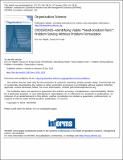CROSSROADS—Identifying Viable “Need–Solution Pairs”: Problem Solving Without Problem Formulation
Author(s)
von Hippel, Eric A.; von Krogh, Georg
DownloadNeed Sol Org Sci as Pub.pdf (1.756Mb)
PUBLISHER_POLICY
Publisher Policy
Article is made available in accordance with the publisher's policy and may be subject to US copyright law. Please refer to the publisher's site for terms of use.
Terms of use
Metadata
Show full item recordAbstract
Problem-solving research and formal problem-solving practice begin with the assumption that a problem has been identified or formulated for solving. The problem-solving process then involves a search for a satisfactory or optimal solution to that problem. In contrast, we propose that, in informal problem solving, a need and a solution are often discovered together and tested for viability as a “need–solution pair.” For example, one may serendipitously discover a new solution and assess it to be worth adopting although the “problem” it would address had not previously been in mind as an object of search or even awareness. In such a case, problem identification and formulation, if done at all, come only after the discovery of the need–solution pair.
We propose the identification of need–solution pairs as an approach to problem solving in which problem formulation is not required. We argue that discovery of viable need–solution pairs without problem formulation may have advantages over problem-initiated problem-solving methods under some conditions. First, it removes the often considerable costs associated with problem formulation. Second, it eliminates the constraints on possible solutions that any problem formulation will inevitably apply.
Date issued
2015-12Department
Sloan School of ManagementJournal
Organization Science
Publisher
Institute for Operations Research and the Management Sciences (INFORMS)
Citation
Von Hippel, Eric, and Georg von Krogh. “CROSSROADS—Identifying Viable ‘Need–Solution Pairs’: Problem Solving Without Problem Formulation.” Organization Science 27:1 (January 2016), pp.207-221.
Version: Final published version
ISSN
1047-7039
1526-5455